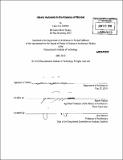| dc.contributor.advisor | Nasser Rabbat. | en_US |
| dc.contributor.author | Schmidt, Laura Lee | en_US |
| dc.contributor.other | Massachusetts Institute of Technology. Dept. of Architecture. | en_US |
| dc.date.accessioned | 2010-10-12T18:28:13Z | |
| dc.date.available | 2010-10-12T18:28:13Z | |
| dc.date.copyright | 2010 | en_US |
| dc.date.issued | 2010 | en_US |
| dc.identifier.uri | http://hdl.handle.net/1721.1/59207 | |
| dc.description | Thesis (S.M.)--Massachusetts Institute of Technology, Dept. of Architecture, 2010. | en_US |
| dc.description | Includes bibliographical references (p. 151-154). | en_US |
| dc.description.abstract | This thesis looks at the interpretive difficulties posed by the Islamic automata, or hiyal manuscript--an ingenious genre of medieval illustrated manuscripts that describes and depicts mechanical devices such as water clocks, trick vessels, and automata. I choose to focus on the ways in which the automata manuscript has been viewed by scholars, rather than providing a history of the manuscripts themselves, precisely because this latter effort is complicated by a scholarly anxiety with what, exactly, Islamic automata manuscripts are, how they were used, or if (and how) they are valuable. This anxiety reveals not only a deeply subjective discontent with our totalizing "bourgeois" notion of technology - one that claims that we progress only by perfecting our implements - but also points to an inability to overcome this discontent. The way that this discontent is revealed through automata is that this "bourgeois" notion is not only totalizing, but also European. Automata scholarship thus allows us to see how European technology itself can be totalizing. The thesis reviews interpretive trends of this literature: The art historical origins of automata scholarship; mid century scholarship that touted the functional principles of the devices, and today's framework, which places automata in a linear technological evolution towards robotics, cybernetics, and advancement of human self-reproduction. Automata scholarship throughout has maintained a sterile distance from the historical context of the automata production. To close this gap, I argue, the ideological character of the Islamic automata manuscript must be revealed and its problematical relationship to technology disenchanted at every step. | en_US |
| dc.description.statementofresponsibility | by Laura Lee Schmidt. | en_US |
| dc.format.extent | 161 p. | en_US |
| dc.language.iso | eng | en_US |
| dc.publisher | Massachusetts Institute of Technology | en_US |
| dc.rights | M.I.T. theses are protected by
copyright. They may be viewed from this source for any purpose, but
reproduction or distribution in any format is prohibited without written
permission. See provided URL for inquiries about permission. | en_US |
| dc.rights.uri | http://dspace.mit.edu/handle/1721.1/7582 | en_US |
| dc.subject | Architecture. | en_US |
| dc.title | Islamic automata in the absence of wonder | en_US |
| dc.type | Thesis | en_US |
| dc.description.degree | S.M. | en_US |
| dc.contributor.department | Massachusetts Institute of Technology. Department of Architecture | |
| dc.identifier.oclc | 665870862 | en_US |
